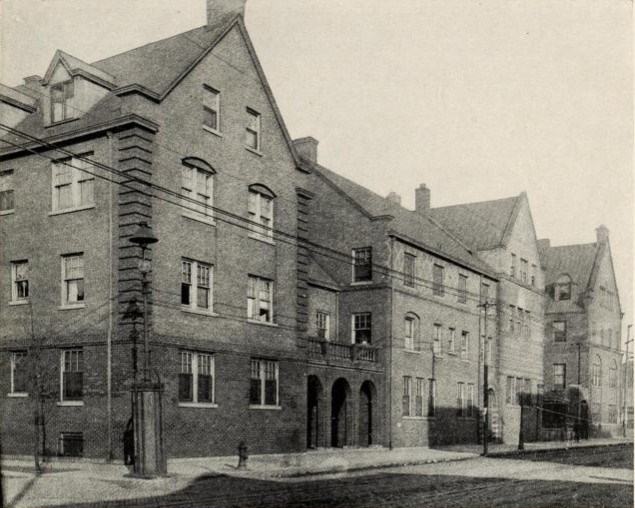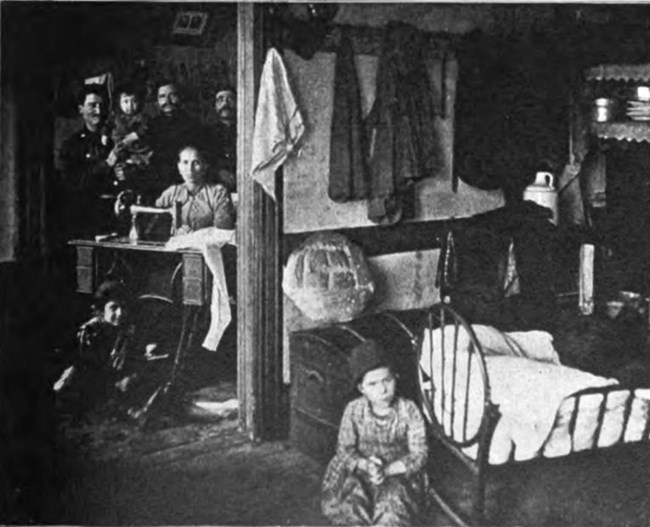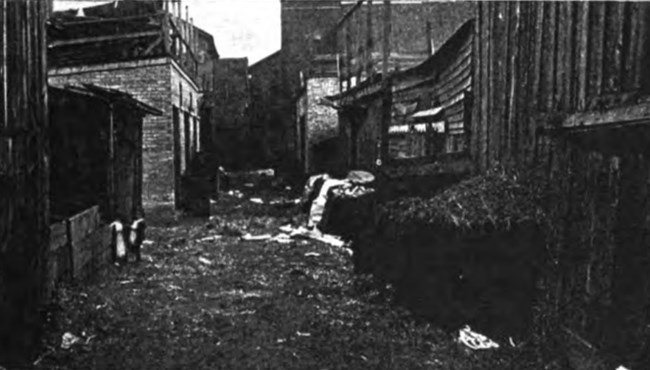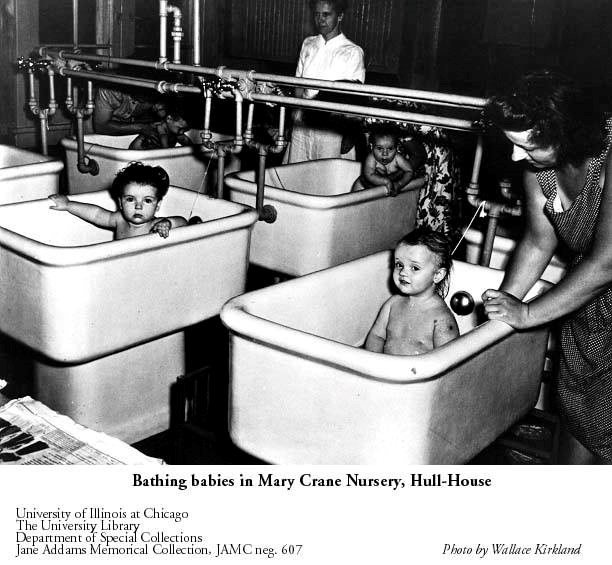Last updated: January 6, 2021
Article
Hull-House and the ‘Garbage Ladies’ of Chicago

https://archive.org/details/hullhouseyearboo1906hull/mode/2up
During the early 1900s, working-class immigrants in Chicago endured housing problems and unsanitary living conditions. To address these issues, social reformers established institutions called settlement houses, which offered social services for the community. Hull-House was the first settlement house established in the United States. It was designated a National Historic Landmark in 1965.
Many Hull-House staff members were white women who came from upper- and middle-class families. They focused on decent housing as a basic need and led the charge to reform the city’s waste disposal, sanitation, and housing services. At least one reformer became known as the “Garbage Lady” for her efforts.

“Foul Beyond Description”
In 1889, Jane Addams and Ellen Gates Starr founded Hull-House in the Nineteenth Ward on the Near West Side of Chicago. Hull-House offered social services for working-class immigrants who primarily came from Eastern Europe and lived in the ward. Many of them worked in local sweatshops and garment factories and earned low wages.Community residents faced unsanitary conditions at home and at work. The Nineteenth Ward was densely populated and there were not enough places to live. The Chicago River separated the ward from the city’s central business district known as the Loop. The river and back alleys became dumping grounds for manufacturers who cared more about profits than public welfare. When the river flooded and the sewers overflowed, human waste and garbage spilled into the streets. Diseases spread quickly and contributed to the highest infant mortality rate in the city.
Addams offered a vivid description in her book Twenty Years at Hull-House. She wrote:
“The streets are inexpressibly dirty, the number of schools inadequate, sanitary legislation unenforced, the street lighting bad, the paving miserable and altogether lacking in the alleys and smaller streets, and the stables foul beyond description.”

https://catalog.hathitrust.org/Record/000955441
The ‘Garbage Ladies’
Some Hull-House residents took their concerns beyond providing services at the House and advocated for improved community infrastructure and other social improvements. Hull House Women’s Club members spearheaded sanitation and housing reforms. In 1898, the mayor appointed Jane Addams as Chicago’s first woman garbage inspector. Two years later, Addams and children’s rights activist Florence Kelley conducted a mapping project and door-to-door surveys in the Nineteenth Ward. They documented how the ward’s physical conditions affected the health of the people living there.Addams and Kelley also studied if bad plumbing and contaminated water helped to spread typhoid fever and other diseases. Addams tasked Hull-House worker and epidemiologist Dr. Alice Hamilton to investigate. Hamilton discovered that house flies transmitted the disease. Her data underpinned several sanitation regulations enacted for residences and workplaces.
Mary McDowell, a former Hull-House kindergarten teacher and Hull-House Women’s Club member, became known as the “Garbage Lady” and “Angel of the Stockyards.” McDowell had researched European garbage collection systems and led a settlement house in the Back of the Yards neighborhood on the South Side. At her urging, the city created a Commission on Waste in 1913. McDowell served as the chairperson. In this role, she directed efforts to clean up the Bubbly Creek branch of the Chicago River. It was called Bubbly Creek because South Side meatpackers routinely dumped so much waste into the river that it “bubbled up.”
Ultimately, Addams and Kelley’s survey exposed the corruption, negligence, and indifference at the root of the ward’s housing problems. Their data illustrated a relationship between a neighborhood’s cleanliness and its land rents. Manufacturers, landlords, city officials, and politicians profited from Chicago's ethnic and class divisions. Addams and Kelley revealed how these groups unfairly enforced sanitation and building codes to maintain slums and advance their own interests.

Photo from the Jane Addams Memorial Collection, University of Illinois at Chicago (https://explore.chicagocollections.org/ead/uic/25/nk66/)
Beyond the Bins and to the Ballot Box
Addams also encouraged non-activist women to become involved. In her 1910 essay, “Why Women Should Vote,” she urged women to extend their traditional domestic duties to the ballot box. Addams stressed that women’s “individual conscience and devotion are no longer effective” to safeguard their families. Modern society had grown too big and complicated. Health and safety were now “utterly dependent upon the city administration” to enact laws to “protect the home from the dangers incident to modern life.” Addams argued that voting for these regulations enabled women to continue to fulfill their traditional duties.Hull-House workers also advocated for protective labor laws for women and children and other social and political reforms. They demonstrated the powerful impact that women could have on the environment and the political landscape.
Selected Sources:
Addams, Jane. Twenty Years at Hull-House with Autobiographical Notes. New York: Macmillan, 1912. A Celebration of Women Writers. University of Pennsylvania Digital Library. Accessed December 15, 2020.
Addams, Jane. “Why Women Should Vote.” Ladies’ Home Journal 27 (January 1910): 21-22. Jane Addams Digital Edition. Accessed December 15, 2020.
Hunter, Robert. Tenement Conditions in Chicago. City Homes Association, 1901.
Mann, Susan A. “Pioneers of Ecofeminism and Environmental Justice.” Feminist Formations 23, no. 2 (Summer 2011): 1-25. Accessed December 15, 2020.
Platt, Harold L. “Jane Addams and the Ward Boss Revisited: Class, Politics, and Public Health in Chicago, 1890-1930.” Environmental History 5, no. 2 (April 2000): 194-222. Accessed December 15, 2020.
